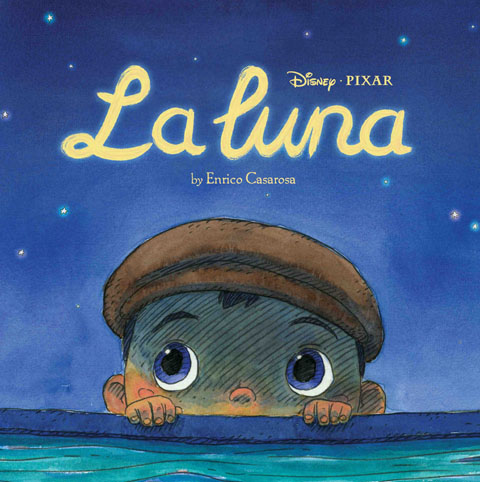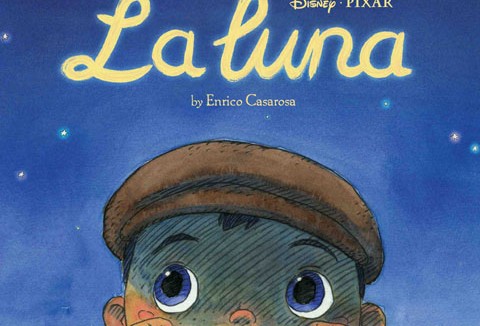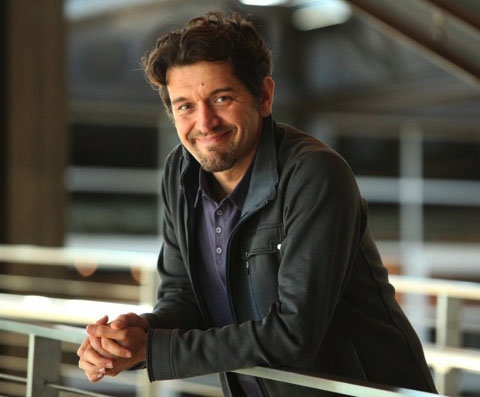

Oscar Focus: Enrico Casarosa Talks “La Luna”
BREWMASTERS NOTE: This week Cartoon Brew takes a closer look at the five Academy Award nominated animated shorts. Each day at 10am EST/7am PST we will post an exclusive interview with the director(s) of one of the films. Today, we discuss Pixar’s La Luna with its writer/director Enrico Casarosa:
Jerry: Enrico, how long were you at Pixar before La Luna?
Enrico: Roughly 8 years. I’ve been there 10 years this month, and it was a couple of years ago that I pitched La Luna.
Jerry: You worked on Ratatouille…
Enrico: Yes, I worked on Ratatouille, a little bit on Cars and Up, and then a little bit on Cars 2. It sounds funny, but in eight years I was mostly on two movies. But then, of course, these movies are marathon. (laughter)
Jerry: What is the pitch process for shorts at Pixar? Is John Lasseter open at all times or does he takes pitches for shorts a couple of times a year? How does that work?
Enrico: There isn’t really a standard way, or a “pitch day” or anything like that. I just kinda said “Can I pitch something? I’d love to.” And they said, “Yeah, sure! This is a good time.” So it’s a little bit about time, and a little bit about getting in front of him, but he does get to see ideas and pitches pretty often. John and his team like to see three ideas – so I worked for maybe three months preparing three pitches. And then you get your day in the sun, trying to see if they react to some of your ideas. They loved La Luna right away, so it got really exciting pretty quickly. They were like “Alright! Let’s do this!” Then it was all about finding the right time for production; it took a little bit of waiting.
Jerry: When you got a go ahead from John for La Luna, did he ask you to go back and do some boards or develop it some more beyond the first pitch?
Enrico: The first time I pitched, I pitched it with image boards, beat boards. I made twenty-something water colors. So after the go-ahead, the next step was to board it. And slowly, you’re aiming for locking your storyboards, creating your story reel. Once you’re locked for that, you can really start production. So those are the steps you start on. But there was confidence we would make it, so there wasn’t any, “Well, let’s see…” Luckily, La Luna had kind of the shape it had, and never changed. We tightened some bolts which made it stronger, with some great notes from a lot of people. But the story was always there–which is often not the case with a lot of our other projects. And then you get into the production once you get the go-ahead on your reels.
Jerry: Tell us about where the story came from. You say it’s based on feelings that you had when you were a kid…
Enrico: Yes. Yeah, very much so. I grew up in Genoa [Italy], and first of all, the setting was something I wanted to capture. The Mediterranean Sea…. I grew up with it in front of my eyes every day, you know? It was a wonderful setting and I wanted to bring that flavor to the screen. We designed the boats to look exactly like boats from that area, for example. But then, the real core was the fact that I lived with my Dad and my Grandfather and they never got along…
I really recalled that feeling of being a little kid stuck between two people telling you to “Do this” or “No, do that!”. It was a bit uncomfortable and difficult to find your own way. So I thought that that would be an interesting thing to try to have as the core; telling the story of a boy who wants to find his own way, but doesn’t want to displease either his Dad or Grandfather. He has to find his own middle way, I guess. That felt like something personal but it is also universal – and that’s what we look for often in our stories. If you can relate something you’ve experienced, you can have something to say, and people can usually connect to those experiences.
Jerry: I really like the fact that your individual drawing style actually translates, or comes through, in the final CG designs. I know that you were influenced a lot by Miyazaki, and I can certainly see some of that in there. Can you tell us about that influence?
Enrico: Absolutely. Yeah, I’ve loved, studied, watched and grew up with all of his movies and TV series, so Miyazaki is in my DNA. (laughter) But the way he develops a story, with image boards, he’s writing with images. That’s something I totally love, and I think it’s great. You know, I don’t really sit at a computer writing a script. I think, “OK, what do I want to see happen in this story.” And that’s perfect for this medium, it’s such a visual way of telling a story. I did it very much like he did, making image boards and making water colors. Everybody loved the water colors. They were like, “Do you want to do it in 2D?” And I said, “Well, no, I’d love to do it at Pixar with the tools we have here, but I would love to bring some of that traditional media to the 3D.” So we really tried to scan watercolors, scan watercolor textures, scan big brush strokes and bring a lot texture into our shading and lighting.
Jerry: Right.
Enrico: We used a lot of pastels, actually, in our backdrops. It was really great to put real media on the screen. Our sky is really a big pastel that Bill Cone did. The team embraced it and it was really wonderful. They were like, “Yeah! Ok, I’m not going to do this with Photoshop, I’m going to water color it and then scan it.” So they embraced it.
Jerry: Those were your drawings at the end of the film, right?
Enrico: That’s correct. It was really fun to use, straight out, my work at the end… although in some ways, the struggle all along was to bring some of that into the whole short. But it was really fun to make this tiny little limited animation piece for the end credits.
Jerry: The collector in me is asking: Is there a La Luna children’s book coming out?
Enrico: There is! This was another chance I had to actually use my water colors, which is great. With Disney Press, we usually put out a book for each of the shorts. So I was able to just watercolor it and do it myself. I worked with a wonderful writer, Kiki Thorpe, on the wording. So yeah, it’s coming out in May. It’s finished and I just got the first advance copy two weeks ago, and we’re so happy with it.

Jerry: I particularly liked that one visual gag – I’m sure everybody mentions it – the one with the brooms and the beards. That’s the kind of gag you don’t really write. That’s the kind of thing that comes out of the drawings, when you do the storyboards.
Enrico: Yeah, I came into the idea of designing them in a specific way – that it would really be a fun thing for these guys to become almost like their tools. And then what became important for me, for that gag, was the fact that it be seen from the boys point of view. And honestly, and I get a lot of comments on this, it’s that moment where you really feel like, “Oh look–this is really how kids see the world.” These are the little weird things kids notice. And that’s what I really like about that moment. It just feels like you are in his shoes and ultimately you feel a little bit like the way we used to feel about things. I like that, it’s very much a sense of wonder and silliness we have as kids.
Jerry: For me, that’s really the whole point of the film. Once he understands what they’re about to do, and what they’re doing, he’s the one who comes up with the solution at the end. It’s perfect child’s-point-of-view story telling.
Enrico: I think the sense of wonder and the boy’s perspective are really the most important thing for me there. Just trying to get to the magic you feel as a kid. I love movies that make me feel that way. I also wanted to give kids a good message, “Go for it! Trust your instincts!” Find your own path.
Jerry: I’m still excited that they’re still doing shorts at Pixar. Not to dismiss the ones tied into Toy Story or Monsters Inc. or anything, but I love the original shorts. One thing that excites me about Pixar’s shorts, and I don’t really know if it can be said of shorts anywhere else, is that they harken back to the old studio system. You have a luxury of utilizing the people working there – the technicians, the artists, the animators – all on staff. You really have more time to dwell on aspects of design and story in a way that other short filmmakers might not be able to.
Is there any chance Pixar will stop producing them?
Enrico: Oh no no, John believes in them strongly. I think he believes in mentoring people like me who can come up with a good idea. There’s a wonderful short I just looked at this last week that is in the making, it’s already looking great. And there’s more in development. So there’s a great belief in them because they allow us to show our range. After spending years on our various feature films, it’s great to say, “Hey look, we made something different!”

